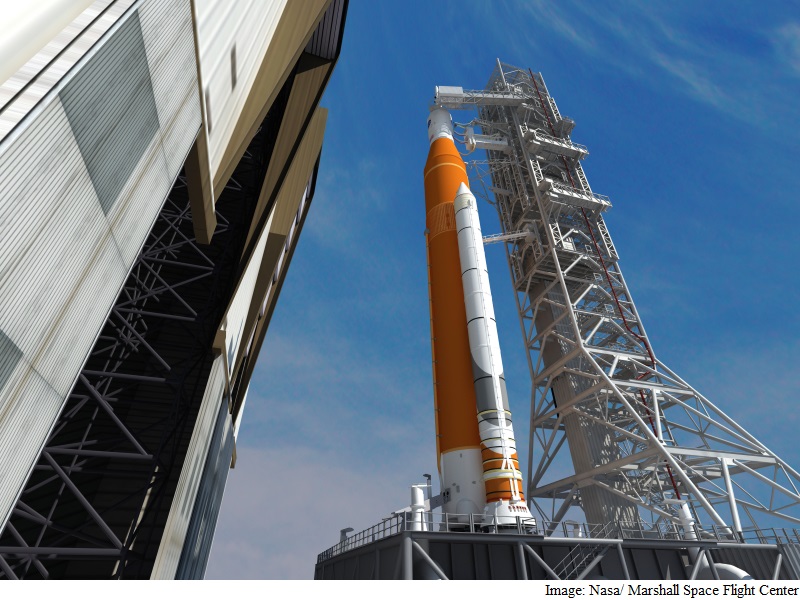- Home
- Science
- Science News
- Nasa Clears Another Hurdle for Its Mega Spacecraft to Mars
Nasa Clears Another Hurdle for Its Mega Spacecraft to Mars

After completing this milestone on its journey to Mars, Nasa is ready to begin another phase of work on SLS where the next generation of astronauts will be sent to Mars and other deep-space destinations.
"Nasa is developing and modernising the ground systems at Kennedy to safely integrate Orion with SLS, move the vehicle to the pad, and successfully launch it into space," said Bill Hill, deputy associate administrator of Nasa's exploration systems development division.
"Modernising the ground systems for our journey to Mars also ensures long-term sustainability and affordability to meet future needs of the multi-use spaceport," he added in a statement.
Engineers and experts reviewed hundreds of documents as part of a comprehensive assessment.
The Ground Systems Development and Operations Program (GSDO), responsible for processing SLS and Orion for flight and ensuring all systems and facilities are ready, completed its critical design review (CDR) of the facilities and ground support systems plans in December 2015.
In the final step before actual fabrication, installation and testing of Kennedy's ground systems, the GSDO programme and review board briefed the results of their assessments to Nasa's Agency Program Management Council, led by associate administrator Robert Lightfoot.
Engineers are transforming Kennedy's launch infrastructure to support the SLS rocket and Orion spacecraft.
The heavy-lift rocket will be stacked in the Vehicle Assembly Building on the mobile launcher and roll out to Launch Pad 39B atop a modified crawler transporter.
The Orion spacecraft will be fueled with propellants in the multi-payload processing facility at Kennedy prior to stacking atop the rocket.
The launch team will use the new command and control system in the firing room as the clock counts down to liftoff of SLS's first flight.
"The team is working hard and we are making remarkable progress transforming our facilities," said Mike Bolger, GSDO programme manager.
For the spacecraft's first mission on the SLS rocket, ESA (European Space Agency) is providing Orion's service module which powers, propels, cools and provides consumables like air and water in space.
Get your daily dose of tech news, reviews, and insights, in under 80 characters on Gadgets 360 Turbo. Connect with fellow tech lovers on our Forum. Follow us on X, Facebook, WhatsApp, Threads and Google News for instant updates. Catch all the action on our YouTube channel.
Related Stories
- Samsung Galaxy Unpacked 2025
- ChatGPT
- Redmi Note 14 Pro+
- iPhone 16
- Apple Vision Pro
- Oneplus 12
- OnePlus Nord CE 3 Lite 5G
- iPhone 13
- Xiaomi 14 Pro
- Oppo Find N3
- Tecno Spark Go (2023)
- Realme V30
- Best Phones Under 25000
- Samsung Galaxy S24 Series
- Cryptocurrency
- iQoo 12
- Samsung Galaxy S24 Ultra
- Giottus
- Samsung Galaxy Z Flip 5
- Apple 'Scary Fast'
- Housefull 5
- GoPro Hero 12 Black Review
- Invincible Season 2
- JioGlass
- HD Ready TV
- Laptop Under 50000
- Smartwatch Under 10000
- Latest Mobile Phones
- Compare Phones
- Redmi Note 15 5G
- Redmi Note 15 Pro 5G
- Redmi Note 15 Pro+ 5G
- Lava Play Max
- Poco C85 5G
- Honor Magic 8 Lite
- Jolla Phone
- Realme P4x 5G
- Asus ProArt P16
- MacBook Pro 14-inch (M5, 2025)
- OnePlus Pad Go 2
- Poco Pad M1
- Just Corseca Skywatch Pro
- Honor Watch X5
- Acerpure Nitro Z Series 100-inch QLED TV
- Samsung 43 Inch LED Ultra HD (4K) Smart TV (UA43UE81AFULXL)
- Asus ROG Ally
- Nintendo Switch Lite
- Haier 1.6 Ton 5 Star Inverter Split AC (HSU19G-MZAID5BN-INV)
- Haier 1.6 Ton 5 Star Inverter Split AC (HSU19G-MZAIM5BN-INV)

















